Toyota 4Runner: If you have a flat tire
Remove the flat tire and replace it with the spare tire provided.
Before jacking up the vehicle
• Stop the vehicle on a hard, flat surface.
• Set the parking brake.
• Shift the shift lever to P.
• Stop the engine.
• Turn on the emergency flashers.
Location of the spare tire, jack and tools
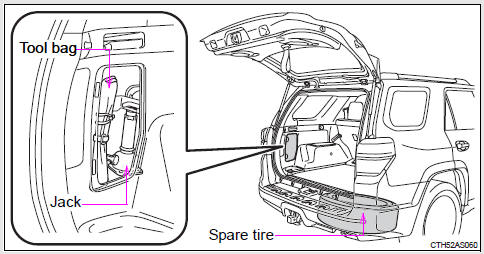
Taking out the jack and tool bag
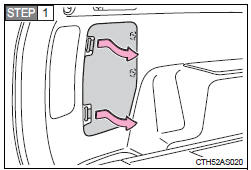
Remove the cover.
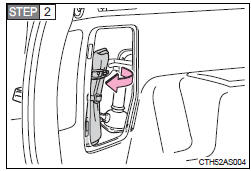
Unhook and take out the tool bag.
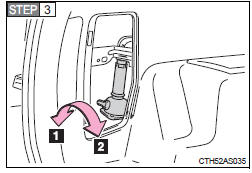
Take out the jack.
1. For loosening
2. For tightening
Taking out the spare tire
 Assembling the jack handle.
Assembling the jack handle.
Remove the jack handle and the jack handle extension bar from the tool bag and assembly by following these steps.

1. Loosen the bolt and the screw using either the jack handle or a screwdriver.

2. Assemble the jack handle extension bars and tighten the bolt.
Check that the bolt is firmly tightened.

3. Assemble the jack handle and the jack handle extension bar and tighten the screw.
Check that the screw is firmly tightened.

Insert the end of the jack handle extension into the lowering screw and turn it counterclockwise.
Lower the spare tire completely to the ground.

Pull out the spare tire and remove the holding bracket.
Replacing a flat tire

Chock the tires.


Remove the wheel ornament using the wheel ornament remover.
To protect the wheel ornament, place a rag between the wheel ornament remover and the wheel ornament, as shown in the illustration.

Slightly loosen the wheel nuts (one turn).
 Assembling the jack handle.
Assembling the jack handle.
Remove the jack handle, jack handle extension bar and jack handle bar from the tool bag and assemble by following these steps.

1. Loosen the bolts and the screw using either the jack handle or a screwdriver.

2. Assemble the jack handle extension bars and the jack handle bar and tighten the bolts.
Check that the bolts are firmly tightened.

3. Assemble the jack handle extension bar and the jack handle and tighten the screw.
Check that the screw is firmly tightened.

Position the jack at the jack points as shown.
Front - Under the chassis frame side rail Rear - Under the rear axle housing

Raise the vehicle until the tire is slightly raised off the ground.
When positioning the jack under the rear axle housing, make sure the groove on the top of the jack fits with the rear axle housing.

Remove all the wheel nuts and the tire.
When resting the tire on the ground, place the tire so that the wheel design faces up to avoid scratching the wheel surface.
Installing the spare tire

Remove any dirt or foreign matter from the wheel contact surface.
If foreign matter is on the wheel contact surface, the wheel nuts may loosen while the vehicle is in motion, causing the tire to come off.
 Install the spare tire and
Install the spare tire and
loosely tighten each wheel nut by hand by approximately the same amount.

When replacing an aluminum wheel with a steel wheel, tighten the wheel nuts until the tapered portion comes into loose contact with the disc wheel seat.

When replacing an aluminum wheel with an aluminum wheel, tighten the wheel nuts until the washers comes into contact with the disc wheel.

Lower the vehicle.
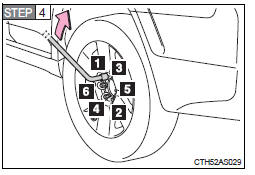
Firmly tighten each wheel nut two or three times in the order shown in the illustration.
Tightening torque:
81 ft
•lbf (110 N
•m, 11.2 kgf
•m)
Stowing the flat/spare tire, jack and tools
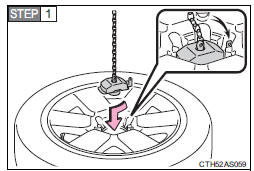
Lay down the tire with the outer side facing up, and install the holding bracket.
Insert the holding bracket tab into one of the holes in the wheel.
 Raise the tire.
Raise the tire.
Vehicles with kinetic dynamic suspension: Pull the tire toward the rear of the vehicle when raising. After raising, visually check that tire is not interfering with components.
 Stow the tools and jack
Stow the tools and jack
securely, and replace the cover.
After completing the tire change
The tire pressure warning system must be reset.
When using the spare tire
As the spare tire is not equipped with a tire pressure warning valve and transmitter, low inflation pressure of the spare tire will not be indicated by the tire pressure warning system. Also, if you replace the spare tire after the tire pressure warning light comes on, the light remains on.
CAUTION
Using the tire jack
Improper use of the tire jack may cause the vehicle to suddenly fall off the jack, leading to death or serious injury.
• Do not use the tire jack for any purpose other than replacing tires or installing and removing tire chains.
• Only use the tire jack that comes with this vehicle for replacing a flat tire.
Do not use it on other vehicles, and do not use other tire jacks for replacing tires on this vehicle.
• Always check that the tire jack is securely set to the jack point.
• Do not put any part of your body under the vehicle while it is supported by the jack.
• Do not start or run the engine while your vehicle is supported by the jack.
• Do not raise the vehicle while someone is inside.
• When raising the vehicle, do not put an object on or under the jack.
• Do not raise the vehicle to a height greater than that required to replace the
tire.
• Use a jack stand if it is necessary to get under the vehicle.
Vehicles with Automatic running boards
• Observe the following precautions. Failure to do so may result in serious injury:
• When jacking up the vehicle, always turn the Automatic running boards switch
off.
• When jacking up the vehicle, do not use an Automatic running board as a jack
point. The Automatic running board may break, causing injuries.
Take particular care when lowering the vehicle to ensure that no one working on or near the vehicle may be injured.
CAUTION
Using the jack handle
Tighten all the jack handle bolts securely using a Phillips-head screwdriver, to prevent the extension parts from coming apart unexpectedly.
Replacing a flat tire
• Observe the following precautions.
Failure to do so may result in serious injury:
• Lower the spare tire completely to the ground before removing it from under
the vehicle.
• Do not try to remove the wheel ornament by hand. Take due care in handling the
ornament to avoid unexpected personal injury.
• Do not attach a heavily damaged wheel ornament, as it may fly off the wheel while the vehicle is moving.
• Do not touch the disc wheels or the area around the brakes immediately after the vehicle has been driven.
After the vehicle has been driven the disc wheels and the area around the brakes will be extremely hot. Touching these areas with hands, feet or other body parts while changing a tire, etc. may result in burns.
• Failure to follow these precautions could cause the wheel nuts to loosen and
the tire to fall off, resulting in death or serious injury.
• Have the wheel nuts tightened with a torque wrench to 81 ft
• lbf (110 N
• m, 11.2 kgf
• m) as soon as possible after changing wheels.
• When installing a tire, only use wheel nuts that have been specifically designed for that wheel.
• If there are any cracks or deformations in the bolt screws, nut threads or bolt holes of the wheel, have the vehicle inspected by your Toyota dealer.
• When installing the wheel nuts, be sure to install them with the tapered ends facing inward.
NOTICE
Do not drive the vehicle with a flat tire
Do not continue driving with a flat tire.
Driving even a short distance with a flat tire can damage the tire and the wheel beyond repair.
When stowing the flat tire
Ensure that there is no object caught between the tire and the vehicle underbody.
When replacing the tires
• When removing or fitting the wheels, tires or the tire pressure warning valve and transmitter, contact your Toyota dealer as the tire pressure warning valve and transmitter may be damaged if not handled correctly.
• Replace the grommets for the tire pressure warning valves and transmitters as well.
To avoid damage to the tire pressure warning valves and transmitters
When a tire is repaired with liquid sealants, the tire pressure warning valve and transmitter may not operate properly. If a liquid sealant is used, contact your Toyota dealer or other qualified service shop as soon as possible. Make sure to replace the tire pressure warning valve and transmitter when replacing the tire.
 If a warning light turns on or a warning buzzer sounds
If a warning light turns on or a warning buzzer sounds
Calmly perform the following actions if any of the warning lights comes on
or flashes. If a light comes on or flashes, but then goes off, this does not
necessarily indicate a malfunction in the sy ...
 If the engine will not start
If the engine will not start
If the engine will not start even though correct starting procedures are
being followed (, 173), consider each of the following points:
The engine will not start even though the starter motor opera ...
Other materials about Toyota 4Runner:
Dtc Check / Clear
DTC CHECK / CLEAR
1. CHECK DTC
HINT:
When DTC B1650/32 is stored as a result of troubleshooting for the airbag system,
perform troubleshooting for the occupant classification system.
(a) Connect the Techstream to the DLC3.
(b) Turn the ignition switch t ...
Components
COMPONENTS
ILLUSTRATION
ILLUSTRATION
ILLUSTRATION
ILLUSTRATION
ILLUSTRATION
...
0.0396
